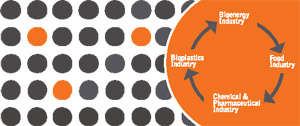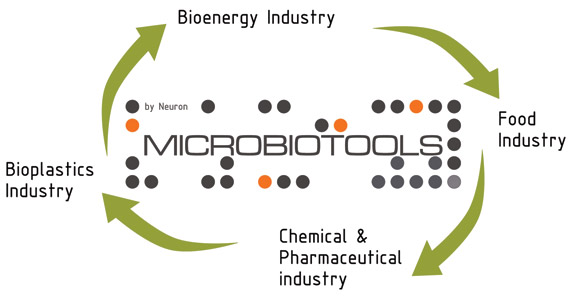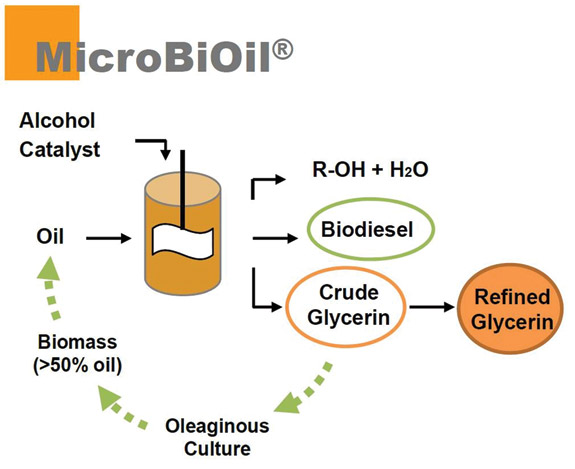MicroBiOil: From Crude Glycerin to Biodiesel




May 19, 2010
BY Malena Valdivieso
Organic byproducts or residues generated from industrial processes of agro-food, forestry or industrial processes are likely to be used as feedstock for the production of higher value-added compounds by using microorganisms or enzymes. Among the more interesting products is crude glycerin from the biodiesel industry. The growth rate of the biodiesel market has generated a similar increase in the production of glycerin as the byproduct accounts for one-tenth the volume of biodiesel produced at any methyl ester plant.
The global biodiesel industry has grown significantly over the past decade. Before the economic slowdown, it was estimated that the global biodiesel market would reach 37 billion gallons by 2016, growing at an average annual rate of 42 percent(1). The rapid development of the global biodiesel industry has been closely observed by countries interested in stimulating economic growth, improving the environment and reducing dependency on imported oil. In 2008, biodiesel production in Europe reached 7.75 million tons (2.3 billion gallons) and it was estimated that the surplus of crude glycerin on this continent was more than 700 kilotons per year(2). In the U.S., crude glycerin production reached approximately 251 kilotons per year(3). A rapid expansion in biodiesel production capacity is being observed not only in developed countries but also in developing countries such as Brazil, Argentina, Indonesia and Malaysia.
In recent years the U.S. Congress has put in place a number of tax incentive programs that positively impact the biodiesel industry(4). These programs are designed to make biodiesel price competitive with conventional diesel fuel, and are structured in a manner that allows the value of the incentive to be recognized immediately in the market price of the biodiesel.
Refined glycerin has traditionally been used as raw material in cosmetics or pharmaceutical application. Refining the crude glycerin, which contains residual organic impurities, is too expensive and complex for small producers. Thus, 50 percent of the total crude glycerin byproduct generated is disposed of, with the remaining sold at a minimal price.
Crude glycerin's present commercial value is between $35 and 75$ a ton, and is expected to decrease in the near future. This has led biofuel companies to start considering crude glycerin as a waste that cannot be ignored. Researchers in the biotechnology industry are well aware of this situation and have recently invested in the means to develop technologies to convert glycerin to value-added products.
Although biodiesel can be obtained, theoretically, by any triglyceride of plant or animal origin, much of the current global production is focused on the use of vegetable oils from seeds such as sunflower and rapeseed (Europe), soybeans (U.S.) or coconut (Philippines), and fruits such as palm (Malaysia and Indonesia). Biodiesel produced from crops is a good alternative source but depends heavily on raw material prices, which can represent more than 60 percent of the cost of the process, not to mention the potential conflict with using "food" crops.
The search for other possible sources of raw materials has focused on new varieties of plants and microorganisms for oil production(5,6). The fatty-acid profile should contain saturated fatty acids (myristic, palmitic and stearic acid), monounsaturated (oleic acid) and a small proportion of linoleic acid (18:2). This fatty-acid profile is similar to the profile of plant varieties used in the conventional process (soybean, sunflower, rapeseed and palm) so that the biodiesel produced meets the specifications set by the European standard EN 14214.
Although all microorganisms must synthesize a small amount of lipids to membranes and other functional and structural issues, only a small number are able to accumulate lipids in an amount exceeding 20 percent of cell mass as reserve material. Among more than 600 species of yeasts and 70,000 molds, only about 125 are capable of accumulating lipid concentrations above this percentage(7,8). Oleaginous micro-organisms are considered an attractive alternative source of lipids due to the possibility of reducing the cost of production processes using inexpensive substrates, their ability to synthesize a range of different products, finding more efficacy and strain availability of genetic techniques for improvement. It has been demonstrated that such microbial oils, also called "single cell oils" (SCO), can be used as feedstock for biodiesel production. Compared to other vegetable oils and animal fats, the production of SCO has many advantages, such as a short life cycle, less labor required, less affected by venue, season and climate and easier to scale up(9).
Neuron BioIndustrial, a division of Neuron BPh based in Granada, Spain, has recently developed a new process to metabolize raw glycerin to turn it into microbial oil able to be used as raw material for biodiesel production. Using microorganisms as biocatalysts, Neuron BioIndustrial makes possible the conversion of this byproduct into a value-added compound.
MicroBioTools
MicroBioTools (registered trademark) is the technological platform created by Neuron BioIndustrial to develop "tailor-made" bioprocesses for different applications (Figure 1). The platform is based on an exclusive collection of more than 8,000 micro-organisms (bacteria, molds, yeasts and microalgae) isolated from extreme ecosystems.
MicroBioTools enables us to find quickly and efficiently the right micro-organism to develop bioprocesses to obtain added-value compounds from different industrial residues or byproducts. Through this platform, the company is able to find the best candidates that can metabolize raw materials and produce value compounds; and microbes are isolated from specific environments worldwide by high throughput screening. These techniques are used to find the best candidate strain for a specific process. Once selected, the strain and the process optimization program starts. The resulting process is then scaled up in bioreactors from 5 to 30 liters (1.3 to 7.9 gallons) in our laboratories to obtain the maximum yield and productivity. The process is finally scaled up in industrial bioreactors in sizes from 300 to 2,000 liters.
So far, the company has developed some processes to be applied in different industrial areas such as pharmaceutical, agro-food and biofuel companies. Such strategy contributes to improving profitability of actual production processes, and to reducing their environmental impact. The processes are developed up to pilot scale including an economic and technical feasibility study for their industrial scale-up.
MicroBioOil
Currently, one of the most innovative bioprocesses of MicroBioTools is the development of MicroBioOil, a new process to metabolize raw glycerin from biodiesel production to turn it into microbial oil to produce biodiesel (Figure 2).
Neuron BioIndustrial has selected a specific type of microorganism that metabolizes large quantities of raw glycerin as the sole carbon source. The resulting microbial mass contains more than 50 percent of its dry weight as lipids. These microorganisms are nonpathogenic and are not genetically modified.
The microbial oil can be extracted by common extraction methods due to its similar composition to oils conventionally used for biodiesel production (e.g., soybean, sunflower oils). This oil can be used as new raw material to produce biodiesel as its properties and fatty acid composition is in accordance with European (EN14214) and American (ASTM D6751) standards. It is also possible to carry out a methanolysis with the microbial biomass to directly obtain the mixture of methyl ester.
Thanks to this technology, the productivity of a biodiesel plant can be increased by 2 to 3 percent. Both the process and the strains used for this technology have been fully developed and patented by Neuron BioIndustrial. MicroBioOil is marketed through licensing agreements and technical consultancy contracts.
References
1. Sims (2007). Biodiesel Magazine. Dec. Issue.
2. European Biodiesel Board. http://www.ebb-eu.org.
3. Monthly Energy Review, Energy Information Administration (2009).
4. National Biodiesel Board. http://www.biodiesel.org
5. Chisti, Y. (2007) Biotechnology Adv., 25: 294-306.
6. Ratledge, C and Cohen, Z (2008) Lipid Technol., 20: 155-160.
7. Q Li, W Du and Dehua L (2008). Appl Microbiol Biotechnol. 80: 749-756.
8. Ratledge,C (2004) Biochimie, 86: 807-815.
9. Q Li and MY Wang (1997). Use food industry waste to produce microbial oil. Science and Technology of food industry. 6: 65-69.
Malena Valdivieso is a research scientist with Neuron BioIndustrial Division of Neuron BPh. Reach her at mvaldivieso@neuronbp.com.
The global biodiesel industry has grown significantly over the past decade. Before the economic slowdown, it was estimated that the global biodiesel market would reach 37 billion gallons by 2016, growing at an average annual rate of 42 percent(1). The rapid development of the global biodiesel industry has been closely observed by countries interested in stimulating economic growth, improving the environment and reducing dependency on imported oil. In 2008, biodiesel production in Europe reached 7.75 million tons (2.3 billion gallons) and it was estimated that the surplus of crude glycerin on this continent was more than 700 kilotons per year(2). In the U.S., crude glycerin production reached approximately 251 kilotons per year(3). A rapid expansion in biodiesel production capacity is being observed not only in developed countries but also in developing countries such as Brazil, Argentina, Indonesia and Malaysia.
In recent years the U.S. Congress has put in place a number of tax incentive programs that positively impact the biodiesel industry(4). These programs are designed to make biodiesel price competitive with conventional diesel fuel, and are structured in a manner that allows the value of the incentive to be recognized immediately in the market price of the biodiesel.
Refined glycerin has traditionally been used as raw material in cosmetics or pharmaceutical application. Refining the crude glycerin, which contains residual organic impurities, is too expensive and complex for small producers. Thus, 50 percent of the total crude glycerin byproduct generated is disposed of, with the remaining sold at a minimal price.
Crude glycerin's present commercial value is between $35 and 75$ a ton, and is expected to decrease in the near future. This has led biofuel companies to start considering crude glycerin as a waste that cannot be ignored. Researchers in the biotechnology industry are well aware of this situation and have recently invested in the means to develop technologies to convert glycerin to value-added products.
Although biodiesel can be obtained, theoretically, by any triglyceride of plant or animal origin, much of the current global production is focused on the use of vegetable oils from seeds such as sunflower and rapeseed (Europe), soybeans (U.S.) or coconut (Philippines), and fruits such as palm (Malaysia and Indonesia). Biodiesel produced from crops is a good alternative source but depends heavily on raw material prices, which can represent more than 60 percent of the cost of the process, not to mention the potential conflict with using "food" crops.
The search for other possible sources of raw materials has focused on new varieties of plants and microorganisms for oil production(5,6). The fatty-acid profile should contain saturated fatty acids (myristic, palmitic and stearic acid), monounsaturated (oleic acid) and a small proportion of linoleic acid (18:2). This fatty-acid profile is similar to the profile of plant varieties used in the conventional process (soybean, sunflower, rapeseed and palm) so that the biodiesel produced meets the specifications set by the European standard EN 14214.
Although all microorganisms must synthesize a small amount of lipids to membranes and other functional and structural issues, only a small number are able to accumulate lipids in an amount exceeding 20 percent of cell mass as reserve material. Among more than 600 species of yeasts and 70,000 molds, only about 125 are capable of accumulating lipid concentrations above this percentage(7,8). Oleaginous micro-organisms are considered an attractive alternative source of lipids due to the possibility of reducing the cost of production processes using inexpensive substrates, their ability to synthesize a range of different products, finding more efficacy and strain availability of genetic techniques for improvement. It has been demonstrated that such microbial oils, also called "single cell oils" (SCO), can be used as feedstock for biodiesel production. Compared to other vegetable oils and animal fats, the production of SCO has many advantages, such as a short life cycle, less labor required, less affected by venue, season and climate and easier to scale up(9).
Neuron BioIndustrial, a division of Neuron BPh based in Granada, Spain, has recently developed a new process to metabolize raw glycerin to turn it into microbial oil able to be used as raw material for biodiesel production. Using microorganisms as biocatalysts, Neuron BioIndustrial makes possible the conversion of this byproduct into a value-added compound.
MicroBioTools
MicroBioTools (registered trademark) is the technological platform created by Neuron BioIndustrial to develop "tailor-made" bioprocesses for different applications (Figure 1). The platform is based on an exclusive collection of more than 8,000 micro-organisms (bacteria, molds, yeasts and microalgae) isolated from extreme ecosystems.
MicroBioTools enables us to find quickly and efficiently the right micro-organism to develop bioprocesses to obtain added-value compounds from different industrial residues or byproducts. Through this platform, the company is able to find the best candidates that can metabolize raw materials and produce value compounds; and microbes are isolated from specific environments worldwide by high throughput screening. These techniques are used to find the best candidate strain for a specific process. Once selected, the strain and the process optimization program starts. The resulting process is then scaled up in bioreactors from 5 to 30 liters (1.3 to 7.9 gallons) in our laboratories to obtain the maximum yield and productivity. The process is finally scaled up in industrial bioreactors in sizes from 300 to 2,000 liters.
So far, the company has developed some processes to be applied in different industrial areas such as pharmaceutical, agro-food and biofuel companies. Such strategy contributes to improving profitability of actual production processes, and to reducing their environmental impact. The processes are developed up to pilot scale including an economic and technical feasibility study for their industrial scale-up.
MicroBioOil
Currently, one of the most innovative bioprocesses of MicroBioTools is the development of MicroBioOil, a new process to metabolize raw glycerin from biodiesel production to turn it into microbial oil to produce biodiesel (Figure 2).
Neuron BioIndustrial has selected a specific type of microorganism that metabolizes large quantities of raw glycerin as the sole carbon source. The resulting microbial mass contains more than 50 percent of its dry weight as lipids. These microorganisms are nonpathogenic and are not genetically modified.
The microbial oil can be extracted by common extraction methods due to its similar composition to oils conventionally used for biodiesel production (e.g., soybean, sunflower oils). This oil can be used as new raw material to produce biodiesel as its properties and fatty acid composition is in accordance with European (EN14214) and American (ASTM D6751) standards. It is also possible to carry out a methanolysis with the microbial biomass to directly obtain the mixture of methyl ester.
Thanks to this technology, the productivity of a biodiesel plant can be increased by 2 to 3 percent. Both the process and the strains used for this technology have been fully developed and patented by Neuron BioIndustrial. MicroBioOil is marketed through licensing agreements and technical consultancy contracts.
References
1. Sims (2007). Biodiesel Magazine. Dec. Issue.
2. European Biodiesel Board. http://www.ebb-eu.org.
3. Monthly Energy Review, Energy Information Administration (2009).
4. National Biodiesel Board. http://www.biodiesel.org
5. Chisti, Y. (2007) Biotechnology Adv., 25: 294-306.
6. Ratledge, C and Cohen, Z (2008) Lipid Technol., 20: 155-160.
7. Q Li, W Du and Dehua L (2008). Appl Microbiol Biotechnol. 80: 749-756.
8. Ratledge,C (2004) Biochimie, 86: 807-815.
9. Q Li and MY Wang (1997). Use food industry waste to produce microbial oil. Science and Technology of food industry. 6: 65-69.
Malena Valdivieso is a research scientist with Neuron BioIndustrial Division of Neuron BPh. Reach her at mvaldivieso@neuronbp.com.
Advertisement
Advertisement
Advertisement
Advertisement
Upcoming Events





